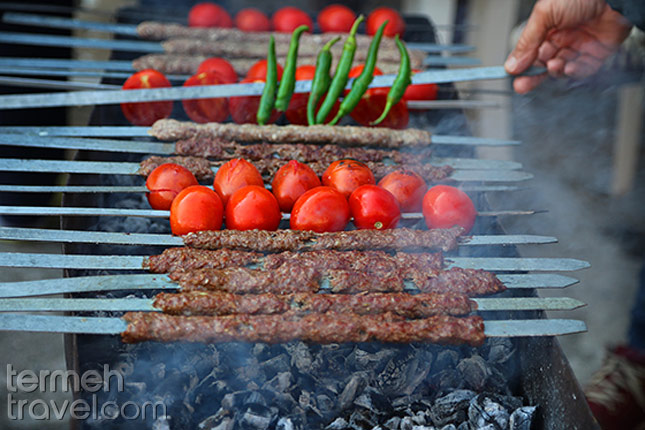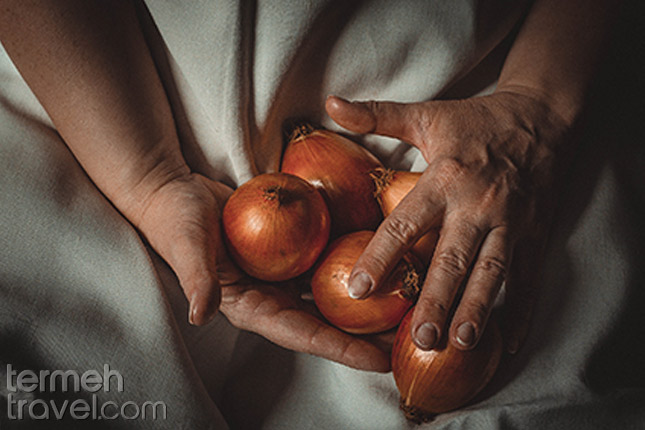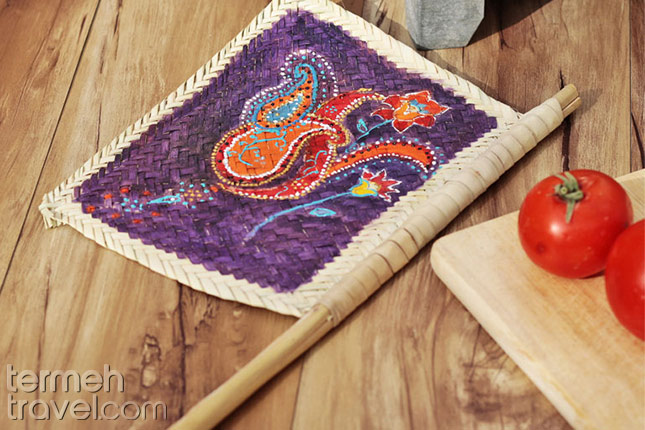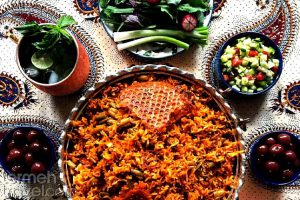Step aside Persian foods, the king has arrived.
Kabab Koobideh is every Iranian child’s favorite. We all remember helping our fathers with the grill and getting sneaky bites of Koobideh wrapped in bread, soaked with delicious runny fat as a reward. Kabab Koobideh is inseparable from Iranian culture. It’s in all Persian weddings, every restaurant’s menu, and Iranian hearts.
The smell is just incredible and can draw you into the Moslem restaurant while walking in the crowded Bazaar of Tehran. You can hear it sizzle in the burning woods of a jungle in the north of Iran, or taste this delicacy in a hospitable house in Shiraz. My grandfather used to say that in the good old days, rice was more expensive than meat, and Kabab shops would give you stick after stick of Kabab as long as you still had rice.
Which parts of Iran are famous for Kabab Koobideh?
Kabab Golpayegani
Golpayegan’s kebab shops are as humble as its people, with simple decorations and a sincere way of service. A whole raw lamb is hanging in the shop. The kabab master cuts a piece of meat from the lamb and grinds it in front of the customer to ensure the quality of the meat. Golpayegani Kabab is fairly thin, yet well cooked and moist, and it’s the closest thing to a homemade Persian kabab that you can get in any restaurant in Iran.
Bonab Kabab

Bonab is world-famous for its onion-crusted 1-meter Kebabs which is really similar to Turkish Kebabs. Traditionally they used a sharp and curved cleaver, big enough to be handled by two hands, to grind the meat and the onions. This special method prevents crushing the material and avoids juice leakage from both meat and the onion. After that, the mixture is formed on huge metal sticks. One Bonab Kabab can be enough for 2-3 persons sometimes. It’s very thick and moist and the grilled chunks of onion give it an incredible smell and taste.
Kateh Kabab of the North

The north of Iran is famous for its kateh, a method in which you simply overcook the rice and avoid draining it to get a mushy yet delicious dish. Put a Persian Kabab on top of Kateh, and you get a Kateh Kabab, but it’s not as simple as that. There is a special way of eating kateh Kabab which doesn’t involve any spoon, fork or even chopsticks. Let’s get back to our roots, join our ancestors, and get in touch with our food, literally!
You need to take a piece of Kabab Koobideh with your bare hands and create a dome of rice under it by twirling your wrist. Now use the thumb to direct this magical mixture of deliciousness into your mouth, hmm yummy.
What do you need to make Kabab Koobideh?
Meat
Your grinding machine must have a sharp blade to avoid crushing the meat and it’s recommended to grind it two times, once on medium size and one time on small.
It’s important that the meat is not fresh, and has been in the refrigerator or freezer for at least a couple of days to keep its shape on the stick. You can use lamb, veal, or a mixture of both but remember that the lamb shouldn’t be too fatty and the veal shouldn’t be too lean. That’s why I recommend using 70% breast and flap of lamb mixed with 30% breast or shank of veal. It’s better to use cold meat when forming, and you need to knead the meat enough to get a sticky texture to prevent the meat from falling off the sticks.
Kneading is pretty similar to a dough but it’s better to be done in a big bowl. Use your knuckles, mix everything up and once in a while take the whole thing up and throw it hard into the bowl. 8-12 minutes of kneading should be enough since our goal is to have sticky meat not tough, and chewy meat.
Onion
For every 1 kg of meat, you need 100-150 gr of onion. The best way of preparing the onion is to use the side of a box grater with the largest holes. After that, you should smash and drain the grated onions, mix it with your meat, and throw away the juice (or use that juice for your Chenjeh kabab). The onion gets rid of that stinky smell of raw meat and makes our kabab fluffy and moist.
Salt
I know that salt is used in almost every food, but it plays a crucial role in Kabab Koobideh. Salt helps the stickiness of the meat along with kneading and all the things we said in previous sections. That’s why you need to make Kabab Koobideh a little bit salty or as Iranians call it Khoshnamak, which literally means salty in a good way.
Sticks and Charcoal
You can cook Kabab Koobideh in the oven, or even on the stove but none of these is even comparable with charcoal. Iranians usually use a charcoal grill called manghal but any charcoal grill would be perfect and you don’t need to buy a manghal. Lime charcoal is usually the best for kababs but any charcoal that you can find is gonna be fine.
Kabab Koobideh needs to be formed on wide, steel sticks. If your sticks are new it’s better to use them once on the grill before using them for Kabab Koobideh. You can also make your hands and the sticks a little bit wet to help the forming process.
Optional Items
I highly recommend tomato Kababs alongside your Kabab Koobideh, you can just slice your tomatoes in half and put them on the sticks. Similar to the tomatoes some people like to have small onions, green peppers, or lamb fat on the sticks, which can be served beside your Kabab Koobideh.
You can use Saffron in the mixture or brush a butter-saffron sauce on your Kabab while cooking but make sure to prevent it from getting burned. You can also add pepper, and sumac on top of Kabab Koobideh while serving.
Some people add eggs and breadcrumbs into the mixture of the Kabab Koobideh to keep its shape and not fall off. But, in my opinion, eggs and breadcrumbs are not suitable and could ruin the authentic taste of your Kabab.
How to make Kabab Koobideh?
Ingredients for 4
700 gr breast and flap of lamb
300 gr breast or shank of veal
150 gr onion
Salt based on your taste
Forming on the sticks
Forming Kabab Koobideh on the sticks with your hands is an art that needs hours of training. It’s really hard to explain it but I will try my best. You can always buy and use a Kabab maker machine, manual or automatic, but the taste of a Kabab formed by hand is just something else.

Make a ball of meat the size of an orange by your dominant hand and try to make the ball into the shape of a thick but short baguette. Take a stick on your other hand and push the baguette of meat on the middle of the stick horizontally. Use your thumb and index finger to spread the meat on the stick, and form it to fit your grill length (30cm-45cm). Now you can use your fingers to make some diagonal lines on the meat.
Don’t be disappointed if you failed the first time, mastering this technique needs patience and a lot of training. You can also put your formed kebabs in the refrigerator for up to 2 hours to make sure that they won’t fall off the sticks.
Cooking
Preparing the charcoals: Make sure that every side of the charcoals are ignited and has a red color. Also, you should try to spread the charcoals throughout your Manghal or grill evenly. Iranians use Badbezan, a special hand fan made of straws or plastic to make sure that charcoals are flaming and hot, especially for the first step of cooking Kabab Koobideh.
Making sure it won’t fall off: Take one stick for a test, put it on your grill, and start blowing air into it with a Badbezan, Japanese hand fan, or anything you can find that would work similarly. It’s really important for the cooking process but don’t overdo and burn the meat. After a couple of minutes and when the meat starts looking gray flip the stick and let it cook. Now you can add your other sticks and repeat the process.
Resting: When your meat is halfway cooked, take Kababs off your grill and rest them under flat bread for some minutes. Meanwhile, you can cook your other sticks, on the grill.
The last touch: The finishing part needs less work on your wrist with the hand fan. Put your kebabs back on the grill and cook them until you see a golden brown color. Adjust the cooking to your preferences. Some people like it more juicy and some like it well done.
Now you can serve it beside some basils, Noon Sangak and Persian rice. Congratulations, you finally made Persian Kabab all by yourself!
A Vegan Alternative for Kabab Koobideh
I found a smokey vegan kabab containing creamy peanut butter, soy sauce, and maple syrup for our vegetarian/vegan friends out there. It’s called Smoky Seitan Kebabs With Peanut Sauce, it’s similar to Kabab Koobideh visually and sounds really delicious. You can read the full recipe on Chooseveg. For more delicious recipes, visit the Top 50 Iranian dishes you must try!

















Well written. I miss kabab koobideh
Thank you so much 😀